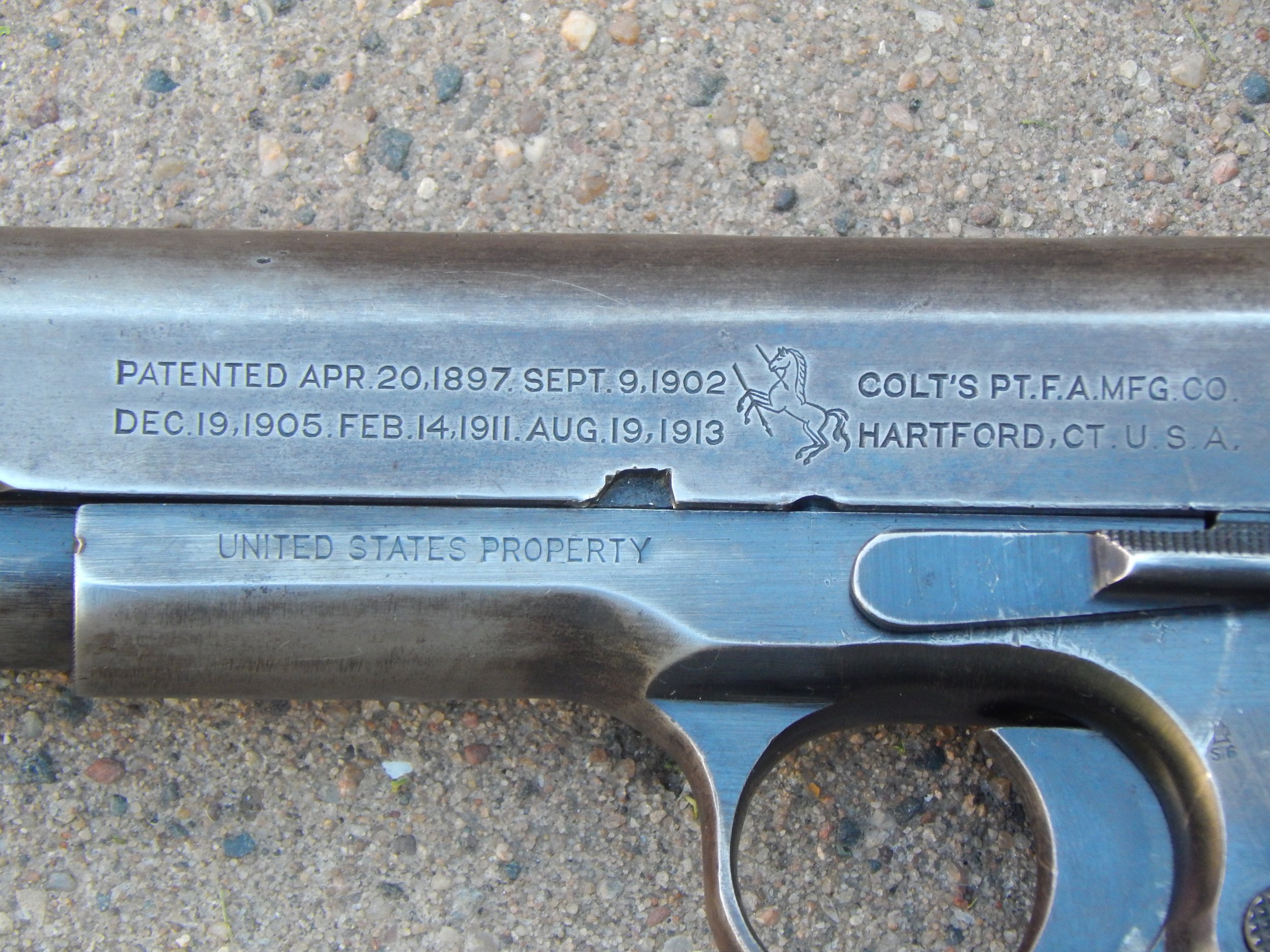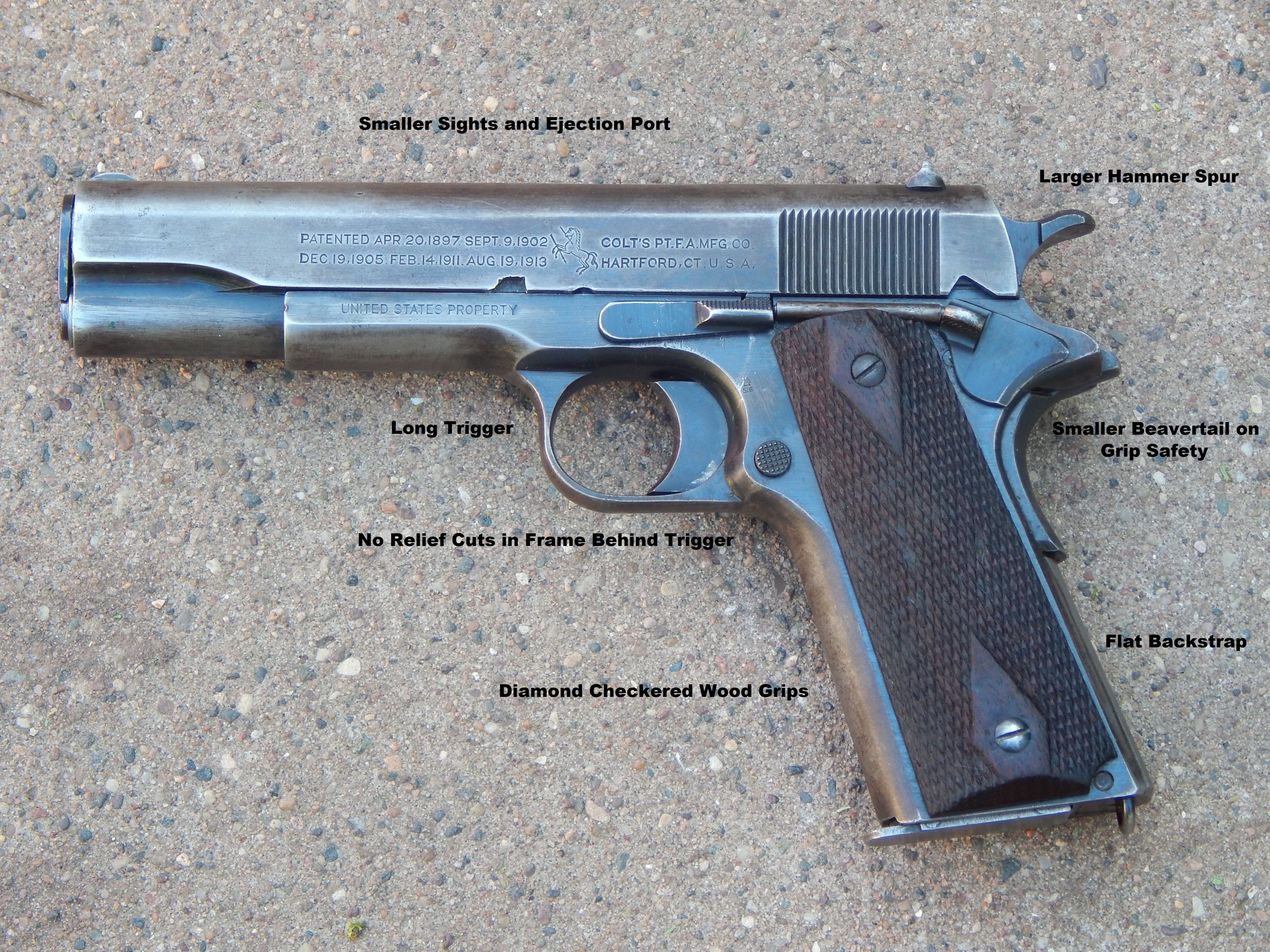M1911
Arguably the most iconic handgun in history, the M1911 .45 would serve the US Armed Forces for over a century, and is an established American icon.
The M1911 was designed by the famous John Moses Browning to fit a requirement issued for a new automatic pistol to replace the various revolvers in service with the US Military in the first decade of the twentieth century, and would go on to equip American and Allied forces in both World Wars and every other conflict involving the country since.
The slide of the M1911, showing the sights and the large hammer and short beavertail combination characteristic of the original military model of the pistol
The History
The United States had a long history of combat pistol use, and placed a higher value on their performance than their European counterparts at the end of the nineteenth century. The Colt M1873 revolver, commonly known as the Single Action Army, was a black powder design chambered in the .45 Long cartridge and had been well liked by soldiers and civilians alike during the age of the American Old West, but improving technologies would lead to a need to replace the design. This quest would lead to the Colt M1892 being adopted and standardized, a double action revolver with a swing-out cylinder chambering the new, smokeless .38 Long Colt cartridge. Adopted alongside the Krag rifle and seeing service in the Spanish American War of 1898, the deficiencies of this cartridge became quickly apparent.
The controls of the M1911: the magazine release button, manual safety, grip safety and single action hammer
The poor performance of the revolver came to a crisis point in the subsequent Philippine Insurrection, where Moro tribesmen proved almost immune to the .38. Often taking drugs before entering combat, the cartridge was simply too anemic to ensure they would be neutralized before being able to kill the American soldier firing at them. This would lead to a temporary re-adoption of the M1873 as a stopgap, followed by the Colt New Army, a double action design still in the .45 Long black powder cartridge, until a suitable, modern handgun could be acquired.
Trials were called for a new .automatic handgun chambering a .45 caliber smokeless cartridge in 1906, with the three front-running designs being one by John Browning made by Colt,
Savage’s M1907, and the German Luger, submitted by DWM. The Luger was eventually withdrawn, leaving only the Savage and Colt designs in the competition over the next few years, until the Colt finally was accepted as the Model of 1911 in March of that year and entered production.
The markings on the M1911. The Colt Pony logo was moved to the center of the slide in 1918, the same year that this pistol was manufactured
By the time that the United States entered the Great War in 1917 some 140,000 pistols had been delivered, and with the entry into the conflict a vast number of new handguns would be needed. With production of the M1911 continuing at Colt as well as Springfield Armory and Remington UMC combinging to attempt to meet a requirement for for over two million M1911 pistols for the war. With so many needed, older revolvers remained in service as well, along with two new .45 revolvers made by Colt and Smith & Wesson as the M1917. Other firms were also contracted to produce the pistol, but the end of the war in late 1918 led to a cancellation of these projects, and a return to relatively limited production, exclusively by Colt.
Changes would later be made to the pistol, leading to the adoption of the improved M1911A1 in 1924, and many of the M1911 pistols in service would be partially upgraded to M1911A1 specifications over the next few decades along with new production, which would peak during the Second World War. The M1911A1 would remain in service for the remainder of the century, despite its official replacement with the 9mm Beretta M9 in 1985. Updated models remain in limited service to this day.
The model designation on the right side of the slide, identifying this M1911 as one purchased by the US Army
The Design
The M1911 is a blowback operated semi-automatic pistol, using the tilting barrel lock system that would become known as the Browning Type. It is a single action design, meaning that the hammer is not cocked via pulling the trigger, requiring the user to manually cock it if needed, although when firing the slide does this automatically.
The pistol is chambered for the .45 ACP (Automatic Colt Pistol) cartridge, with seven cartridges in a standard single stack magazine. The magazine is released via a push-button near the trigger. A hold-open latch locks the pistol open when the last round is fired, with a thumb catch used to release it when reloading. The M1911 features a grip safety along its backstrap, as well as a manual thumb safety on the left hand side of the frame. An internal out-of-battery safety is also present.
The M1911 after field strip. Note the two tone magazine of an early model
This Example
The M1911 seen here was produced in 1918 by Colt for the US Army, and is marked accordingly and in the 430,000 serial number range. Its finish is somewhat worn, but still in many places displays the very dark finish used on pistols produced during the Great War, with this variation known as the “Black Army” by collectors. Notably, this pistol bears no markings other than initial military acceptance proofs, and shows no signs of arsenal rebuild or refurbishment, remaining in its original, as issued state.
The M1911 differs from the later M1911A1 (and thus almost all M1911 type pistols on the market today) in several notable features. These are highlighted above
Opinions
As stated above, there is likely no more iconic handgun than the M1911. The mythos that has evolved around the weapon and its .45 ACP cartridge are undeniable, with the design still seeing use by military forces around the world as well as remaining extremely popular with modern civilian users for various purposes.
The author believes firmly that this is the best handgun issued during the Great War, and remains an excellent design to this day, although in the sum of all features it had been outclassed as early as the Second World War. Despite this, the pistol remains accurate, pleasant to shoot, reliable and powerful, and its history ensures a place in any collection.
A Marine officer on the firing line at a training range in France with his M1911 pistol
Library of Congress
Observed Values and Frequency
Updated: February, 2024
AVERAGE VALUE (USD): $2000 - $4000
FREQUENCY: Rare
COLLECTOR’S NOTES: Reflects the WWI era “Black Army” variant, with finish condition plating a major component as well as having original wartime parts or later replacements.








